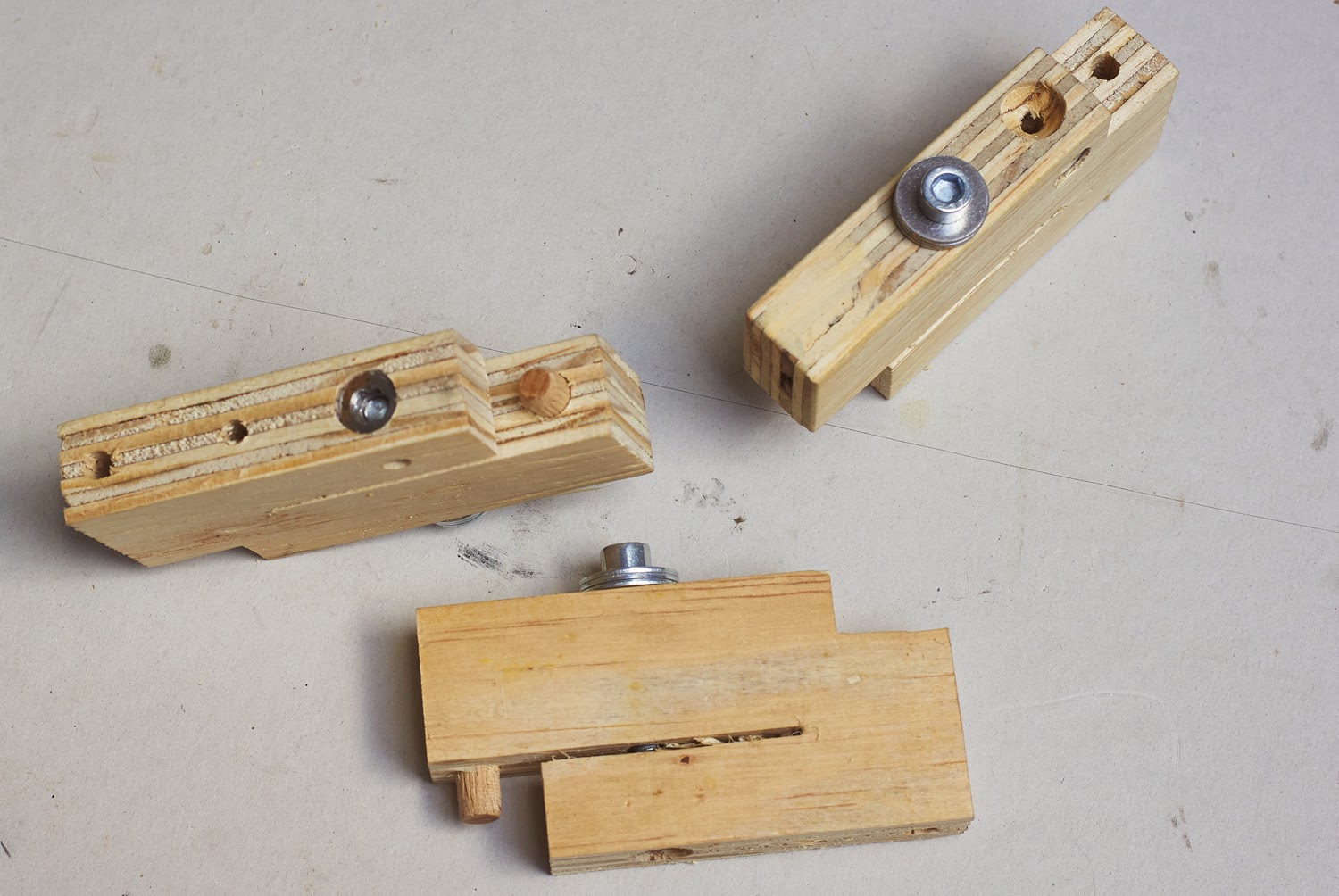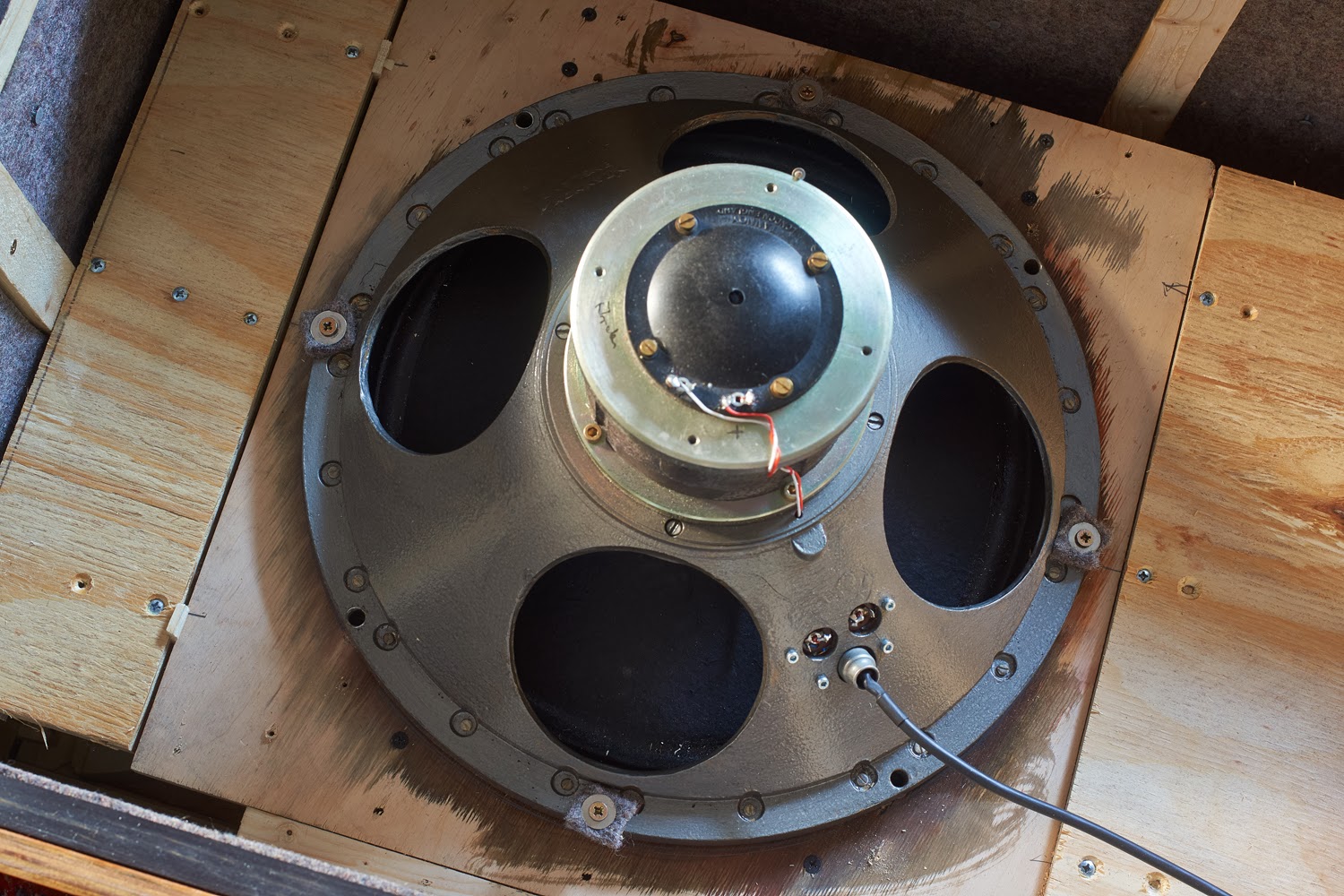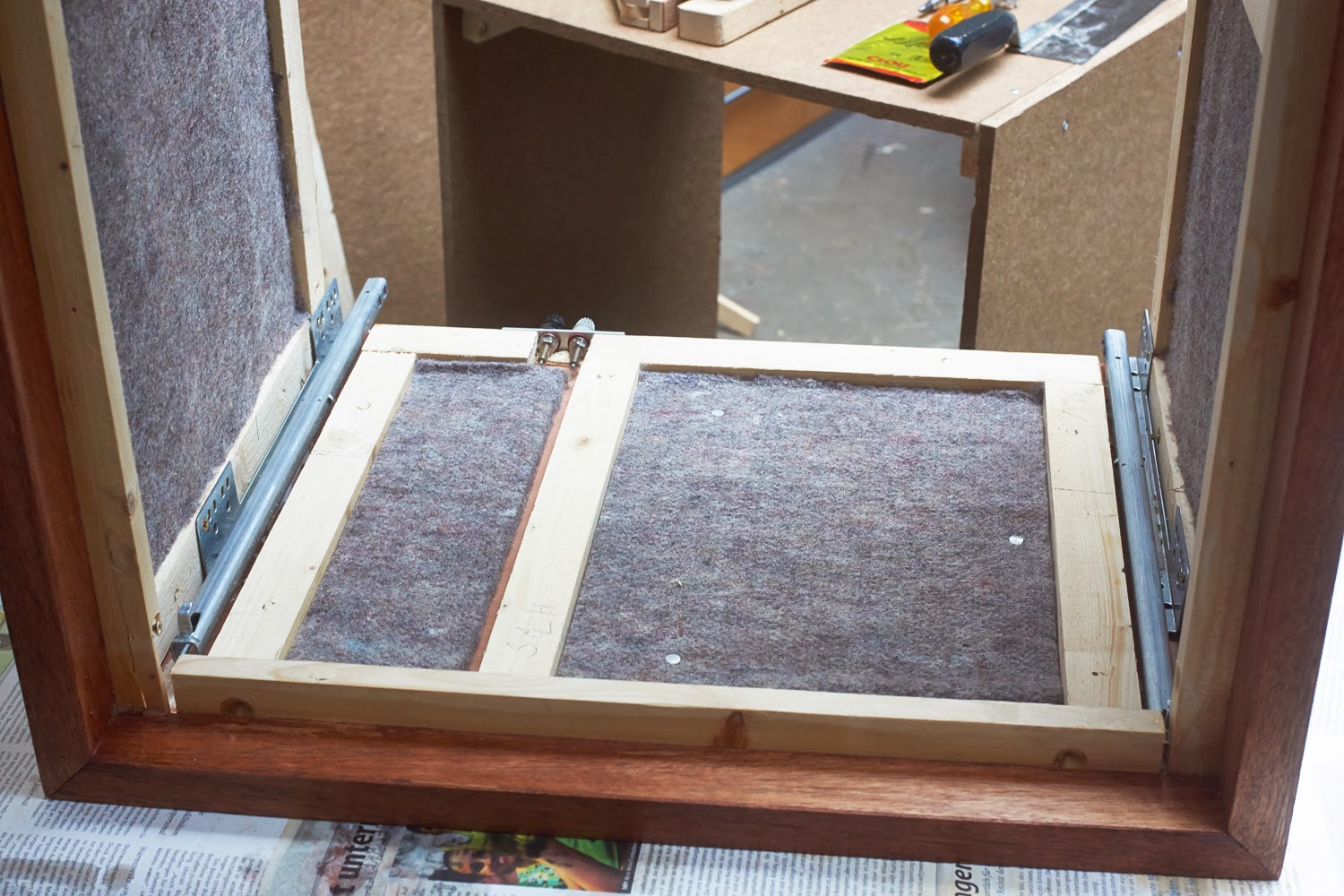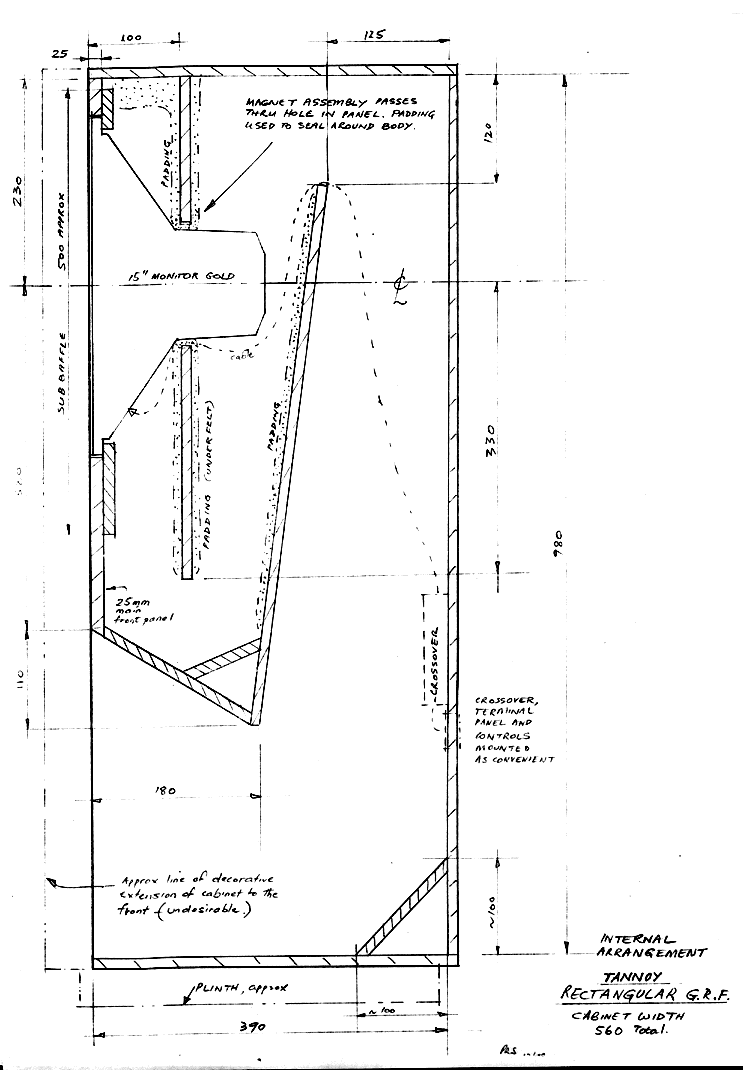But to be honest, like always, when a particular property shows up with a foremost character and over boarding quality, it happens always at the expense of others, in particular with a full range speakers. In my new cabinets the response of the highest frequencies has got influenced very well from the stiffened mounting. The easy natural listenability had suffered, the character of the speakers has now grown very prominent and superficial. This is never a good sign…
The baffle board and the mechanical attachment of the speakers seem to be are a very delicate part of the most designs, it was with all my former cabinets, but here with the support of the horn its influence is tremendous. Sometimes I do ask me, if commercial made speakers (like Altecs, Jensens, Tannoys, JBLs, etc.), ever have been evaluated so critical about all this little details before they got introduced into the market. I really can't believe this, if their designers will have taken this important detail into study? If, there would be other alternatives in mounting big chassis to the baffle boards? With solid full range types or other sorts of duplex speakers a wide range of different sound attitudes can be achieved, just with more or less solid consolidation to the baffle boards (i.e. one built chassis with a covered frequency spectrum from 50 to 10000 hz minimum).
Since I did use the front loaded horn, in particular with DHT preamplification, I have got used to a perfect transparent high frequency response without any hardening or any other sort of degradation. With its wide open, deep and spacious projection, its extremely transparent properties the funnels did engage my main ability to preserve them into my new design. But now, with the new stiffed cabinet, some of this silky response has got lost towards a more technical performance, as well grown to a bit cheeky side. I cannot accept to loose my beloved and very important attributes, so I started a venue to find this refinements back. Such enterprises are always a part of the similar game, independent if the trip will enter electronic wonderlands or like here, the relationships of mechanical resonances between design and built materials. My aim is to shift the existing resonances in the radiated frequency spectrum up and down, to emphazise were these can be damped, were they are mostly annoying and finally might support the general performance.
 |
| Stiffening of the back board, as well can be seen the tight mounting of the chassis with metal screws |
As a first test I exchanged the stiffening board against solid underpinning struts, in each cabinet two of them did resemble the massive boards. The effect was as expected, the wonderful creaky deep bass was gone and a bit more wooly and soft indifferent low frequency response had taken place, together with almost no change of the hf-response. The all around performance of the cabinets was immediately shifted two classes below their former state. It took not very long and I reassembled back to the solid construction already shown in my last post with the solid boards.
As next step I did dedicate my interest to the mounting of the chassis. In almost any vintage cabinet the mounting between wooden baffle and speaker is realized with double threaded nuts, which are inserted into the baffle board and take the bolts to fasten the speakers. As already said, I always find this construction a very delicate operation, in particular with full frequency radiating chassis. It is going extreme and more than delicate to mount such a 15kg chassis to a baffle board. First the simple way of a thin walled baffle, where the chassis is mounted with short wood screws. This simple way can work quite well with sealed or reflex enclosure types of smaller size. Second the way of double layered multiplex boards with 24mm thickness to form the baffle (like the 1970 diy schematics published by Tannoy) is a very difficult approach to harmonies in the response. Since the strengthened boards are always shifting the performance into a more or less edged sound with harsh ends. Additionally the chassis are fixed with inlaying nuts and solid screws tightened till the wrench brakes.
Between these two designs almost any degree of prominent resonances is possible, just the way their physical ability to handle them will change the general property to work like a instrument.
 |
| A selection of different mounting materials, screws, bolts, nuts and wooden clamps types evaluated with this cabinets. |
The older speakers from the Tannoy range even strengthen further with eight wholes instead of four. In short the massive tight construction gives way for a more technical orientated soundstage, since the opposite design opens the way for a mild more natural tonality with refined harmonies, always at the dangerous border to indifferent detail. Almost any state in-between these two positions can be achieved, depending on the character of the amplifying electronics.
In all my former evaluations with speaker cabinets I ended up with a less tight, more natural relaxed attitude of well balanced long listenability. Here now with the funnel I wanted to go a similar way, but have to find new options to realize the first path, since the funnel makes it more complicated.
My next idea was to design wooden holders which will resemble the nuts in the baffle board. For that reason I made some wooden clamps, which will press the speaker from the back side to the funnel (i.e. baffle board). This construction will have the option to adjust the tightening power precisely and distribute it by a wooden lever to the chassis. The wooden design makes a much refined transition point between speaker resonances and cabinet possible. Were the classic bolts are more or less tight or not, here a wider variation of tightness and as result of the wooden material, a improved distribution of the introduced resonances will be obtainable.
 |
| Specially designed wooden clamps to improve and control the pressure and therefore the resonance introduction coming from the chassis into the baffle. |
With the clamps installed the general sound relaxes a lot, the medium frequencies get back into a perfectly refined performance and as well the hf-response improves remarkably. "…at the cost of other properties…", I did say. Yes, the lf-response suffered here, it lost precision, got wooly and overloaded in power. For the first sight it was acceptable, but I did realize immediately, it needed another idea to get all the resonances better distributed, but I had no idea yet were to search. With the building of the clamps, I did already feel like a classic instrument maker, since such introductions are "everyday bread" in this job. It looks, that it is all is a play of tightening and less tightening; to get both directions of energy into the right balance of control with contradictive effects.
I did improve the design of the clamps with the second made generation so, that they will be able to have a better distribution of energy. I did introduce the wooden dowels in order to bring the pressing right into the mounting holes of the chassis. I fixed the clamps whis double wood screws to the baffle board. With the effect, that the all around performance improved the right way, but still the named problems stayed in reduced stage. So it needed another try to get the cabinets forward to sing.
I came back to my originally used bolts and nuts. I bought rubber washers of 2mm thickness and introduces these to decouple the metal bolts from the chassis. Now everything turned back, the lf-response got bettered with fastness and tightness, the medium frequencies rounded up, but the hf-response was again a bit to prominent. Now I had the opportunity to adjust the power of tightening by turning the screws a half turn forward or back. No way, no position got out a acceptable performance, it always sounded prominent and shrill.
 |
| The perfect sounding solution, the simple and technically poor mounting with felt damped wood screws |
So I made a very easy try. I did cut out washers from my 12mm felt. These got combined with iron washers and simple wood drilling screws. This sandwich got screwed tight till the felt compressed into the holes, there were four empty ones with each chassis. So I only had to remove the other bolts with rubber washers and could listen directly to the new mounting principle.
Unbelievable, a fundamental change came up. A completely improved performance of all frequencies was immediate, with a fast and airy, well extended lf-response, all other frequencies improved to a so far unknown state. A three dimensional holographic performance was suddenly present with best dynamics and a perfect sensitivity, without any particular prominence. Just homogenous refined musicality containing a wide scale of harmonies and without any offensive touch. I did listen to a lot of my analogue records this evening, as well I did stream digitally stored material from the hard drive. I did both with a good loudness (always a good sign) and completely pleasured with my new speakers. Now I need to be prevented from myself, not to change this "winning team" again. Even, when I do know that this mounting is technically a less educated solution…
The lesson from this new experience is, to take more than care about this constructive detail, if you are building a cabinet for full range speakers, in particular in the heavy weight class. The mounting of the speaker to the baffle has the same importance the materials for the enclosures itself have, as well the speaker type and finally the principle of enclosure are on par. If a felted washer can make such a difference, – a difference which in the hifi business sometimes will be paid with 1000 or more dollars (for one interconnection for example), than almost any speaker enclosure can be adjusted or improved in a fundamental state, when taking care about this detail.
If you are interested about more results from our music instrument research department read on soon,Volker
























